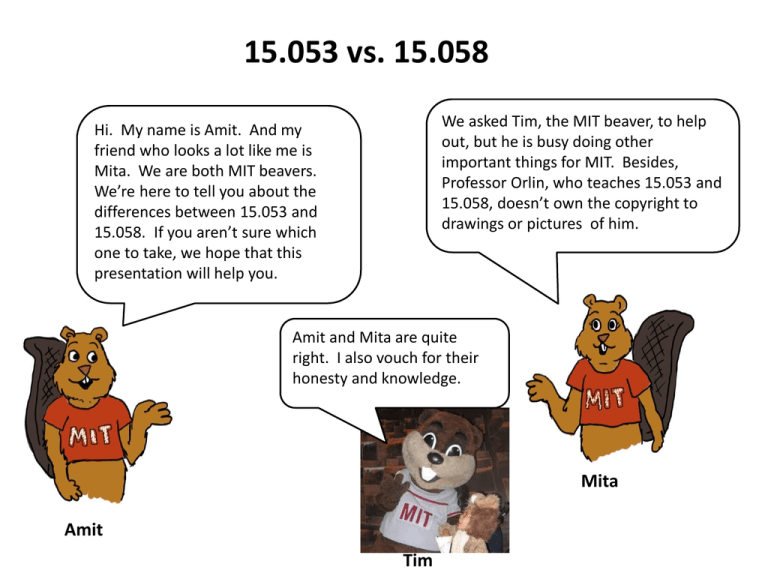15.053 vs. 15.058 - James B. Orlin
advertisement

15.053 vs. 15.058 We asked Tim, the MIT beaver, to help out, but he is busy doing other important things for MIT. Besides, Professor Orlin, who teaches 15.053 and 15.058, doesn’t own the copyright to drawings or pictures of him. Hi. My name is Amit. And my friend who looks a lot like me is Mita. We are both MIT beavers. We’re here to tell you about the differences between 15.053 and 15.058. If you aren’t sure which one to take, we hope that this presentation will help you. Amit and Mita are quite right. I also vouch for their honesty and knowledge. Mita Amit Tim We’ll be joined by some friends who will also help provide some help. You will meet them soon. You may be wondering why cartoon characters are giving you this information. It turns out that Professor Orlin likes us a lot and uses us to explain a variety of things. Most students don’t mind, and it’s always a pleasure for us. By the way, we don’t give the lectures, although we do give some tutorials. I’m Stan the stegosaurus. I can’t wait to meet all of the friends. Amit Stan Mita Hi, I’m Ella the owl. Before listing differences between 15.053 and 15.058, we will list some of the similarities. You can see them on the white board on the next slide. Ella I’m Tom the Turkey. I peeked ahead. The subjects do look very similar. It looks like a great subject for anyone who wants to see mathematics used in the “real world **.” ** For students at MIT, the real world is defined to be the set of places that are not MIT. For faculty and graduate students, the real world is anything outside of academia. By the way, optimization is very useful for decision making at MIT too. Tom As Professor Orlin often says, “Optimization is everywhere.” People want the best value for the cost; manufacturers want to produce the best quality for a given cost of production. Students (and everyone else) want to use their time as efficiently as possible. Financial engineers want to maximize return for a given level of risk. Engineers want optimal designs. Yada Yada Yada. Ella Wow! Does this mean that I can optimize my life after taking 15.053 or 15.058? No, but it would be so cool if you could. The techniques from 15.053 and 15.058 are useful mostly in business (or engineering) decision making where there is a lot of available data and where the value of making better decisions is high. Occasionally, it can be really useful for smaller or more personal decisions. By the end of the course, students will get a good sense where the optimization methods in the subject can be applied, and where it is not so useful to apply them. Tom On the much smaller white board to the right, I’ve listed the key differences between 15.053 and 15.058. I still don’t understand why there are two subjects? How much linear algebra is needed? Does it make a big difference? Why not combine the two courses into a single course? Ella Tom There are really two reasons for having two closely related but different subjects. First of all, we needed a new number for graduate students so that they can obtain graduate credit. The other reason relates to “efficiency of learning”. Some students are very comfortable with the use of matrix notation and its relationship to solving linear systems. They often learn more efficiently if the lectures and readings rely on the use of matrix algebra. 15.058 is better for these students. Other students have not had linear algebra, or have had it but prefer to learn optimization without much matrix notation. 15.053 is better for these students. So, the goal is to optimize the efficiency of learning. I like that. I like the way that the size of the white board was optimized so that we had room to say what we wanted. Ella Stan Tom But how can undergraduates who have had linear algebra know which subject to take? Are they permitted to take 15.053 if they have had linear algebra? Can they take 15.058 if they only know some linear algebra? Students really only need to know the first 1/3 of a linear algebra subject. In order to take 15.058, they should be facile with that material. I think that the best way for students to judge is for them to check out the topics in linear algebra that will be used. They are listed on the next slide. More detail is available on Professor Orlin’s website. Do we have to keep using these name cards underneath our drawings? Ella Tom Stan List of topics from linear algebra • Working with matrices – – – – matrix addition matrix multiplication the transpose of a matrix Identity matrices and permutation matrices • Abstract properties of matrices – linear independence (and linear dependence) of columns and of rows – rank of a matrix • Solving systems of equations – elementary row operations – Gauss-Jordan elimination for solving a system of equations – Determining the inverse of a matrix – Determining when a systems of equations has a solution Here is a rule of thumb for undergraduates deciding between 15.053 and 15.058. If you are relatively comfortable with the concepts on the previous slide, you know enough to take 15.058. But it’s also OK to take 15.053 Another rule of thumb is the following: if you have had 18.06 (or another linear algebra course) and if you obtained a B or better, you will learn more from 15.058 than from 15.053. Another rule of thumb is that you will be really happy with either 15.053 or 15.058. They are both great courses. Also, they are a great way to learn about business analytics and operations research.** What are thumbs? Do thumbs have rules? Tom Ella Stan ** This promotional support was paid for by “Cartoon characters for 15.053 and 15.058.” Some final comments We hope you found these slides helpful. If you still need more information on the differences between 15.053 and 15.058, you can contact Professor Orlin via email at jorlin@mit.edu. Amit I’ll finish with a factoid on the names of the 15.053 and 15.058. 15.053 was renamed “Optimization methods in Management Science” less than 10 years ago. But Professor Orlin originally wanted to use the name “Optimization methods in Operations Research” because he refers to himself as a Professor of Operations Research. But he was talked into using the term Management Science so that it would be the same as the name of the major. So, when 15.058 was created, Professor Orlin decided to call it “Optimization methods in Operations Research.” It sounds as though the distinction between names for 15.053 and 15.058 are meaningful, but it’s not. Management Science is a synonym for Operations Research. Mita Wait! Before you go, I’ll introduce you to my other 15.053 and 15.058 friends. Here they are: • Cathy, the catculating cat. • Nooz, the most trusted name in fox, and • McGraph, a dog who really Excels in making charts and graphs. We all look forward to seeing you soon! Cathy Stan Nooz McGraph These cartoon characters and the others in this presentation were drawn by Liana Moskowitz for Professor Orlin. The copyrights for all cartoon characters in this presentation belong to James Orlin







